Episode #368: How To Convert Math PD Into Classroom Action
LISTEN NOW HERE…
WATCH NOW…
As a K-12 math coordinator, coach, leader are you constantly collecting resources, leading PD, and chasing the next big idea—only to wonder if any of it is actually changing classroom practice?
If you’re a math coach, coordinator, or administrator who feels stuck in a loop of sharing best practices without seeing those practices transferred consistently into the classroom, this episode dives into the heart of that struggle. Kyle Pearce, Yvette Lehman, and Jon Orr confront a challenge many leaders face: how to balance continuous learning with focused implementation. When every new initiative feels urgent, how do you know when it’s time to stop gathering and start doing?
In this episode, you’ll discover:
- Why more math PD doesn’t always equal more impact—and how to recognize the tipping point.
- A smarter approach to setting math goals that actually result in classroom change.
- How to build coordinated support systems in mathematics that turn professional learning into real-world results.
If you’re ready to move from overwhelmed to intentional leadership, press play and let’s reimagine how math professional learning should really work.
Attention District Math Leaders:
Not sure what matters most when designing math improvement plans? Take this assessment and get a free customized report: https://makemathmoments.com/grow/
Ready to design your math improvement plan with guidance, support and using structure? Learn how to follow our 4 stage process. https://growyourmathprogram.com
Looking to supplement your curriculum with problem based lessons and units? Make Math Moments Problem Based Lessons & Units
Be Our Next Podcast Guest!
Join as an Interview Guest or on a Mentoring Moment Call
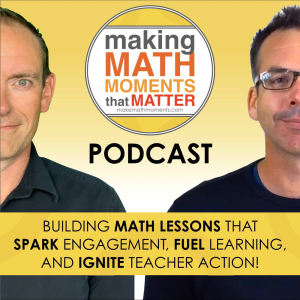
Apply to be a Featured Interview Guest
Book a Mentoring Moment Coaching Call
Are You an Official Math Moment Maker?
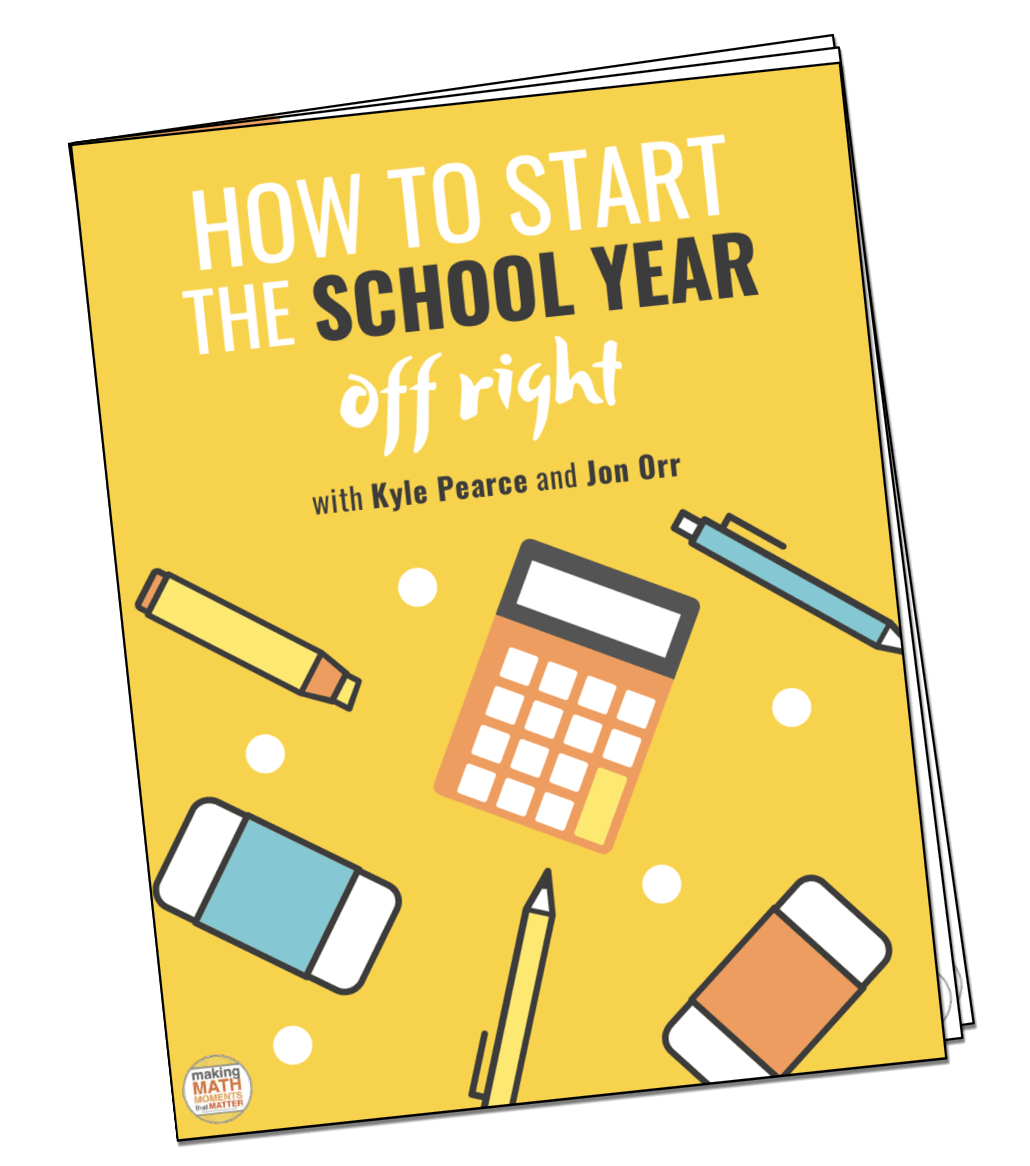
FULL TRANSCRIPT
Jon Orr: In this episode, we’re going to talk about when is the right time to take your foot off the gas or keep your foot on the gas? You know, when is the when is the appropriate amount of learning that we need to do as math coordinators, coaches, administrators, and then apply that learning? And what is that right threshold? It’s like how much how much learning can we do? Like, how much PD can I absorb myself?
How much new ideas and new resources can I gather a new you know, initiatives that I should I think about? Before that becomes too much to handle. And then and then how many of those things actually transfer into the classroom? That’s what we want to talk about here today. It’s gonna be it’s gonna be you know, we’re gonna get heated. This is what happens when we three of us get together and we throw out like a bomb like this be saying like, how much is the right amount of learning that we need to do as leaders?
And then how much of that is transferring into classrooms and with teachers. So I’m starting us off that way. Who wants to jump in?
Kyle Pearce: I’m going to I think I’m going to like end this quick and say we need a lot more. That’s it. A lot more before we are done, you know, and and ultimately, you know what it comes down to is I think we are so ambitious and there’s so many ideas and there’s so many great things we want to do that we very rarely are ever at a place where we’re ready to move on. But we’re moving on anyway. And I know today we’re going to try to
maybe come up with some guidelines, maybe some guide posts, rules, so to speak, that we might want to set for ourselves so that we can try to ensure that the work that we’re doing, because let me be very clear, the work that you are doing in your districts, in your schools, in your grade bands, it’s all amazing work. Like it’s awesome. And the challenge, and I think the part that’s pretty heartbreaking is when you see how hard people are working.
and how much effort they’re putting in to PD plans and all of these great ideas and full day workshops. And all of a sudden it’s like it happens. People enjoy it. They clearly appreciated the learning, but there’s no type of residue after the fact. And I think that happens so routinely. And if we can provide some ideas here as to how you might navigate this a little bit, especially when there are so many demands of your time, of your PD calendar, and of course of your budgets.
Yvette Lehman: I think a common experience we often hear from people who transition from a central office leadership positions, let’s say you’re a coach or coordinator, and then you go back to a school and maybe you go back to the school as a teacher or an administrator. And I am pretty confident most people who make that transition are disappointed because all of the work they’ve been doing, they are not seeing reflected in
the routine classroom practice in that building. And so then they start to question, you know, I just spent, let’s say five years in a central office role, leading professional development, and I’m not seeing any evidence of that learning transfer. And I mean, that’s an exaggeration. I’m sure there is some evidence, but that’s maybe the way they feel.
Kyle Pearce: Sure. Or it just looks very differently in their mind than it does in reality. In their head, they’re like, so many great things must be happening. And we had all of these plans. I think as well, I think one of the sad realities is that we actually don’t see that scenario happening enough for us to learn. Meaning, how many central office staff actually
get back into a school and then get back, into the classroom, it’s so few comparative to the larger group that I think it’s almost worth it for everyone to see and feel what that looks like so that you start to recognize that. And again, it’s not a it’s you issue as a leader. It’s the fact that we think and we overestimate what we can get. accomplished in our PD plans in the very limited amount of time that we have available.
Jon Orr: Like what do you think, you think it’s like we just overestimate or do you think like what else is going on here behind the scenes that says like I’ve done, you know, I’ve spent five years in this role and I’m not seeing it transfer the classroom. Like what’s, you know, what do you think is happening here? You know, there’s a lot of factors that go into this, but I mean what is one of the ones that you would say is a main contributor to, you know, teachers not. making you know the adoptions that you thought we’re making even though you planted all these great PDs and you worked on you grab this you grab that you put this into play and you try this and you collected that resource and what is it?
Kyle Pearce: Well, the quote that pops into my mind, and we’ll have to look it up, and we’ll try to cite it in the show notes, but it’s something along the lines of people massively overestimate what they can accomplish in a year and massively underestimate what they can accomplish in 10. And I might even have, it might have been a month, it might have been, the reality though is that when it’s that short period of time, we tend to think,
that we can do so much more. And I think it’s really hard for us because especially as the person who’s creating the content, who’s creating the plan and is actually going to go do that work through say a workshop, the same happens in our math classrooms where we come in, we’ve done all kinds of thinking about mathematics, about our lesson plan, about exactly how we want it to land and what’s important, what’s not. And we sort of…
think that that one experience for students is going to be enough for them to quote unquote get it right to get the light bulb moment to get the epiphany and the same is true for our educators right we don’t have the repeated exposure opportunity like we do with our students and we see what retention looks like with students it’s so much harder with educators who also have
full plates, you know, when they’re there at that PD, it would be great for them to completely turn off their minds to all other factors in their life. But you know, they have full plates. Many have outside lives, not all of us do, you know, I wasn’t, you know, didn’t have that much of a life going on. I thought a lot about mathematics. But for them, you know, there’s so much going on that, you know, I think when we have that shared experience, and it’s a great opportunity.
Really what we’ve done is we’ve created and we’ve really just sort of touched on the awareness phase, but we haven’t actually been able to get much deeper than that. And then we’re off to the next thing.
Jon Orr: I see. So I think what you’re saying is that you’re saying when we think about the things that we’ve provided throughout the year, or let’s say one PD day that’s coming up, one, you know, we planned that, we delivered it, we’re like, we checked that off the list. Like I delivered that idea, that’s great. Now we can move on to the next idea, and I’ve got like this curriculum to follow, which is kind of like what maybe we have seen in classrooms is like, check.
delivered lesson. But then what you’re I think what you’re saying is that maybe because there’s so many things we’re asking our teachers to do is we just didn’t spend enough time there. And we thought we did, but we just didn’t have the right indicators to tell us how much time we were supposed to spend on that to actually help help it sink into the classrooms. I think that’s what you’re saying. I don’t know, Yvette, what do think?
Yvette Lehman: It makes me think of, think our last episode for Leaders where we talked about a compliance-driven PD calendar, and I think that sometimes we fall into the trap of the we did that mentality. So because we provided six hours, eight hours, 16 hours of training, well, we did that. And so now teachers as professionals should be adopting. But we know that the research suggests that in order for adoption to take place, we need a coordinated subsystem of learning opportunities for educators.
around a single priority. Oftentimes there isn’t a single priority. There are competing priorities across departments because we’re not only trying to strengthen math, right? Right. So imagine you have multiple priorities. You have a compliance driven PD calendar where you can say, did that. You know, we offered this outside in PD where teachers participated in time.
Jon Orr: or no or none no priority no clear priority anyway
Yvette Lehman: type of sit and get potentially, they engaged in a course, whatever it happens to be. But then we don’t have the other systems in place to create that sustainable growth and change. So we don’t align it to coaching, we don’t align it to professional learning communities where there’s collaboration. We don’t bring in the leadership of the school to share that same priority. Imagine this scenario, where as a district, your priority is this in mathematics, but then the school has a math goal that’s completely different from the district goal.
And so I think that one of our challenges is that we end up, like Kyle said, taking on too many goals in a single year and not putting enough support in place for any of them to really transfer and be adopted as a common classroom practice across the district.
Jon Orr: It reminds me of this, you know, this, this idea that I think I heard on a, another, another podcast, which was like, people were boasting, you know, this is like, these were, you know, business leaders, they were boasting about how many, how many books they’d read in a year around, you know, nonfiction books, so books on business development, or books on what leadership, let’s say, let’s like, whatever, just self help books, or they’re getting better books around some sort of topic. And, you know, you can say like, look, I
I read 50 books this year, I read 30 books this year. But then, but then, you know, people were kind of inquisiting to say, Well, well, how many of those ideas that you you gained in those books, did you actually implement? And how many of those were actually going to solve the problem that you currently have, like the pebble that’s rallying in your shoe? Because would you rather read 50 books in each year and then implement none of those things? Or read one book? And, and then that’s helping you solve a problem and then work for the rest of the year?
to implement what you learn in that book and put into action. Because I think that’s what’s happening right now in say our field of like math coordinator, math coach is that we look at like, what can I get my hands on? And I want to collect and I want to grab this resource and I got to understand that and I’m to go to the conference and I’m going to go to 12 sessions and I’m going to bring this back to the district to share.
But then I haven’t clarified, like it’s the same. I read 50 books, I got 50 sessions, I got 50 different resources, I got 50 different things to kind of implement with my teachers. But then I haven’t say mapped out what it looks like to actually implement one of them at a consistent level, or even what it looks like when we have implementation for one of them. Like we don’t even know what that looks like so that we can work towards it.
Kyle Pearce: Well, you know what I’m envisioning, you know, and John, you’ve kind of reminded me a lot of myself because, you know, I’ve been in this role and I know you’ve that you’ve been in that role as well, where you are always wanting to make sure that what it is you’re bringing is relevant, you know, that it’s does this still matter? Does it still work? Like there is that. So we certainly want to continue our learning, of course. And I know you’re not suggesting otherwise here, John, but
I feel like the role when I was envisioning what I what my job was, I had this thought that I was going to bring it to them. And they were going to sort of do the work, you know, like they were going to like put it into action when in reality, instead of me always thinking about what should I do next to share with them, I probably should have had this idea of like, well, here’s the thing.
that we’re going to be focusing in on. I’m going to be there to support you and help you rattle that pebble out of the shoe while you’re putting this into play. I think had I maybe taken more of that approach and more of that perspective, I probably would have spent a lot more time on helping them implement and a whole lot less time in the sharing of things.
And don’t get me wrong, and I’m sure many district leaders out there and coordinators and consultants, you love sharing like it because why because you love teaching. That was what you wanted to do, right? You wanted to teach your students and you wanted to teach other educators some of these ideas. But the reality is, is I think if we if we take more time and we’re there helping them with the implementing, I think what becomes apparent to you is you start to recognize
how much harder this is than maybe I thought in my mind when I was sharing it as an idea, right? And it’s like, it’s one thing for me to go into a classroom and model with a different group of students who are not mine that I don’t have to write report cards for, that I don’t have to call parents and don’t have to check the agendas and do all of those things with just being able to come in, run a lesson, and then be able to disappear. The reality is is that if we’re there and we’re actually
seeing the implementation taking place. And we’re not saying that you’re going to be teaching all these lessons, but you’re there to help. And you’re also there to assess how educators are making out with this process. I think it helps you just like good diagnostic informative assessment data does in our math classroom. Like when I wasn’t watching students do mathematics, I was always surprised at the results on the test.
Kyle Pearce: And I feel like what I’m seeing here is that if I’m going to go and I’m going to implement PD ideas structures, and if I’m not there to see it happening, how am I going to know whether we are far enough in order to start moving on to the next thing? Because I think it becomes quickly apparent to you when you start to see, hmm, you know what, we’re going to need more time on this. If this matters as much as I thought it mattered when I shared this idea back at the last workshop.
Jon Orr: sure, for sure. Like what you’re just saying is that you have identified a problem of practice that you want to solve, which that was turned into a learning goal. You’re saying, Hey, I need to gather information to solve or address this learning goal, which means maybe you need to do the learning as well to kind of like, be in a good position to do that. And then and then you need to then help your teachers achieve the learning goal by setting maybe for yourself, and for them some success criteria, so that you know what it looks like when we hit that learning
and what say implementation looks like or achievement looks like on that learning goal. Doesn’t that sound like a lot like what we’re trying to get teachers to do in math education around assessment and pivoting their lessons or adapting to what students are doing in the room to help them achieve learning goals, right? it’s very clear that if you want to help someone learn something new or try to use say a new skill or a new procedure or a new idea,
that we have to get clear, we have to get clear on what is it that actually we’re solving? What is it that we’re trying to what is it going to look like when we have solved and what and what where are the this the students which are your teachers? You know, where are they on that continuum? And then you can start moving towards the continuum because then then what you’re going to do is you’re going to have the answer to your question is like, should I move on or not? No. Is it still a problem? Yes. Should we continue moving forward? Yes.
And you could not going to jump from one thing to the next because we haven’t solved this one yet. Now, here’s the problem, right, Yvette, is that I can’t do that with everybody. And I can’t I don’t have enough time to say coach and monitor and have a classroom of maybe I have maybe with my time, I could I could do this for 10 teachers, maybe, maybe less like we have teachers do this with 30 plus students on a regular basis, but we see them every day.
if I’ve got say a classroom of 10 teachers or maybe even less, like how, what are we doing to like move things along in that way? Or is it just accepting the, I’m really happy if I can move 10 teachers this year along these continuums. And I really just have to get it, you know, accept that that’s the growth that I’m looking for.
Yvette Lehman: Yeah and I think that it really comes back to again available resources but competing priorities and so if you only have one goal for math this year you might be able to even with limited touch points create systems that support that change because we’re all very laser focused on that change we want to see and that includes our administrators building their capacity building the capacity of maybe one teacher in every building
who can be the informal leader in that building. So I think to your point, John, it’s like, we could continue to jump from thing to thing and download a lot of ideas to the system and really not see a significant change in practice resulting from that. Or we could identify one really high leverage strategy or approach and fully commit a hundred percent
get buy-in from educators, help them, and you talk about this all the time, the adoption model, it’s like we need to understand the why, we need to know why this is important, we need to get buy-in, they need to see it, they need to believe they can do it, they need support, and so often I think if we can’t offer that, we probably shouldn’t just throw something else on their plate and then walk away. Like it’s not really fair to do that, so I can’t just walk in.
throw another idea on their plate and then walk away from that idea with no systems in place to offer any support. It’s really, it’s unfair to our educators. So I think one thing we’ve started to ask people as we have these conversations is what can you commit to? And if all you can commit to is sharing the information or delivering it at one PD session, then it’s probably not worth even bothering because it makes it feel like now you’re asking me to do yet one more thing.
Kyle Pearce: Or maybe say what it is, which is, hey, this is an awareness session. This is a really great idea, and we think it’s amazing, and some of you might wanna run with it, but we can’t actually download specific expectations that each and every person is going to X, Y, or Zed. I mean, yeah, you can, and whether it’s gonna happen or not, right, is the key.
Jon Orr: You can, I think you can, just have to, yeah, this is the big thing I think is like, we can’t do all those things. It’s just, we have to get real on what that’s going to actually change. And I think, cause it’s like, I can keep doing the things that I do and I can keep seeing at the end of the year, know, we’re wondering if any of the things I did this year had any impact and we could start, you know, see that you can look at pulled data wherever you want to pull data.
you can be doing those things. But I think you also just have to accept that without say, those two that that tiered support and that targeted coordinated learning subsystem that you do need to develop inside your school or inside your school district, you’re just gonna have to get real on on on I might not see any change, you know, and then then I think this is what maybe you’re saying is like, is it worth it? Right? You’ve got like, is it worth it for me to like, maybe I need to just change the way I’m supporting
Because it’s probably more worth it to make sure that some teachers have the support that they need. And that might mean restructuring my time to make sure that I can change some teachers or some schools, you know, are hitting some results and making sure that that becomes the focus. Because you can always you can always restructure some of your time to do some of these things. And that’s the better move than say, continue to do what you’re doing now and not know
what’s going to happen at the end of the year and not have say the success criteria mapped out and the priorities mapped out.
Kyle Pearce: Well, and imagine, you know, if there’s this one thing, you know, this one thing, and we actually did this and we actually went in and said, you know, we’re going to really hyper focus on this thing. And we’re not going to introduce any new mandates, requirements, whatever you want to call them until we have some good traction here. And imagine if you lived in a world where that was the way we were going to do something in this system.
We actually followed through on it. And you think of the other benefits that you’ll get as a byproduct. So not only are you gonna actually see some of the results of the thing taking place because you’re actually making that move and you’re being very intentional about it, but think about all of the other mindset shifts that start to happen is that when we commit to something here, we do it, right? And when a new idea comes in, it’s not going to just be dumped on me.
and left and then not followed up on, right? Cause that’s, that’s a lot of people’s approach. Now, you know, there’s the teachers that try to do everything that gets dumped on them and then they go on stress leave or there’s the other teacher who was like, I’ve picked up on the pattern here and it’s only going to matter for, you know, the next couple of weeks. And then all of a sudden I can get back to what I was doing because it’s what I think is best for my kids at this time. We actually do the work and we actually follow through on it.
The beauty is, is they should see some positives coming from by implementing in a good way, in a positive way, in an effective way. But then we’re also gonna start to see, when we do these things, it’s not a last minute thought. It’s not a, you know, we just pulled it out of a random bag, right? The bag of tricks and we threw something out there that we’re actually gonna do this and we’re gonna focus on it. So let’s work on this together. And the reality is,
is if we’re gonna do it well, we’re gonna be properly supported, given the proper time and support in order for these things to happen, because it will take time and it will take support, might be longer in some circumstances and shorter in others. When we do those things, we will naturally start to see that momentum build and we get back to the idea of the flywheel, right? You actually get this flywheel to start moving in a positive direction instead of it always feeling Like we’re just trying to get this thing started for the very first time.
Jon Orr: So I think what we, know, some of the big ideas that we’ve kind of chatted about here is, that we, think for a lot of us, we’ve, we’ve been thinking about our roles as as maybe a sharing role, a gather resources role, and then present role around, you know, what is it that, you know, we can, we can say go to conferences and read books and listen to podcasts and, then share that with our teachers and hope that some of our teachers adopt and transfer some of that into the classroom.
Or, you know, we could think about our roles as supporting roles to achieve, say, goals and priorities that we set for ourselves at the district level that are based on, say, problems of practice that are rooted in research for students in the classrooms and reverse engineer what is it needed to achieve those successes and then plan accordingly as long as we have a coordinated subsystem of learning for our teachers.
at some level, you know, there are implementation levels for each of those subsystems that we can unpack. Setting some success criteria and goals and what does it look like? What does it sound like for continuums to assess teachers? Where they are on those so that we don’t run into this problem where we don’t know when to stop learning new things and sharing those new things with teachers. We actually can, you know,
assess where we are in those goals and then either double down on them or continue to learn from them and then know, hey, now’s the time that we get to move on from this. It’s not because I’m bored. It’s not because I’ve been bored and I’m ready to move on. It’s actually because we’ve seen progress on the things that we’ve I think that’s the approach that we would recommend for you to look at is the role that you currently have and the role that you currently want to have. And that’s the big takeaway here for today.
And if you need a place to get started, head on over to makemathmoments.com forward slash report. There’s a quick survey there that you can fill out. It talks about the six key elements of your math program. And we’ll pinpoint one of those six to get started on and where to start making some changes. So that’s makemathmoments.com forward slash report.
Thanks For Listening
- Book a Math Mentoring Moment
- Apply to be a Featured Interview Guest
- Leave a note in the comment section below.
- Share this show on Twitter, or Facebook.
To help out the show:
- Leave an honest review on iTunes. Your ratings and reviews really help and we read each one.
- Subscribe on iTunes, Google Play, and Spotify.
DOWNLOAD THE 3 ACT MATH TASK TIP SHEET SO THEY RUN WITHOUT A HITCH!
Download the 2-page printable 3 Act Math Tip Sheet to ensure that you have the best start to your journey using 3 Act math Tasks to spark curiosity and fuel sense making in your math classroom!
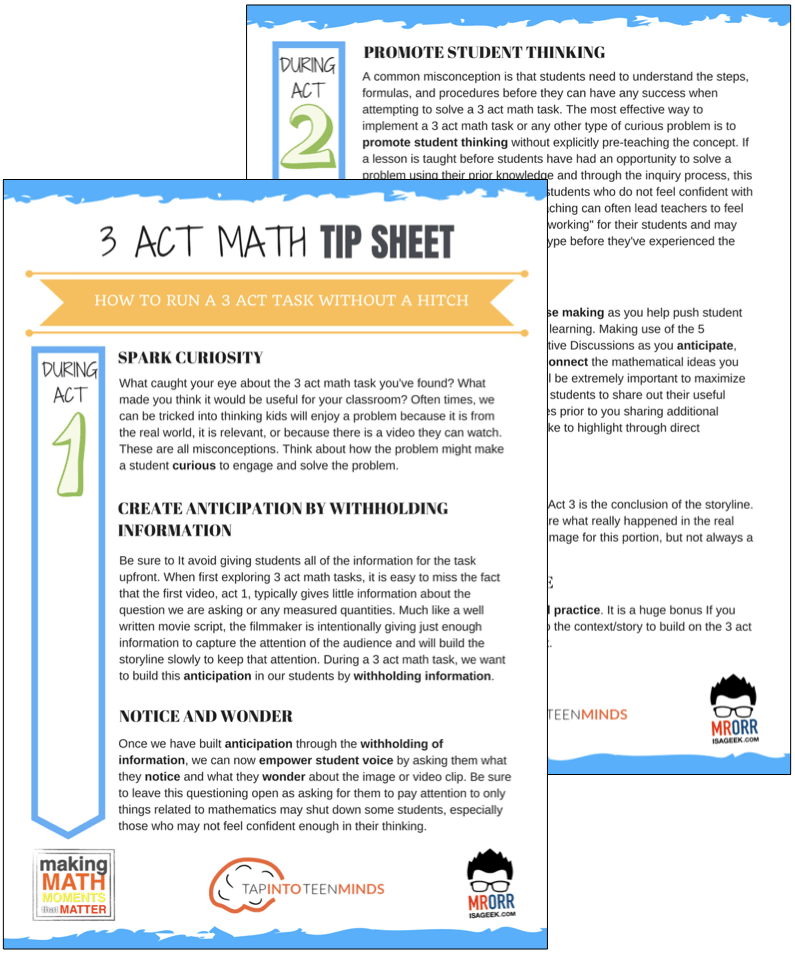
LESSONS TO MAKE MATH MOMENTS
Each lesson consists of:
Each Make Math Moments Problem Based Lesson consists of a Teacher Guide to lead you step-by-step through the planning process to ensure your lesson runs without a hitch!
Each Teacher Guide consists of:
- Intentionality of the lesson;
- A step-by-step walk through of each phase of the lesson;
- Visuals, animations, and videos unpacking big ideas, strategies, and models we intend to emerge during the lesson;
- Sample student approaches to assist in anticipating what your students might do;
- Resources and downloads including Keynote, Powerpoint, Media Files, and Teacher Guide printable PDF; and,
- Much more!
Each Make Math Moments Problem Based Lesson begins with a story, visual, video, or other method to Spark Curiosity through context.
Students will often Notice and Wonder before making an estimate to draw them in and invest in the problem.
After student voice has been heard and acknowledged, we will set students off on a Productive Struggle via a prompt related to the Spark context.
These prompts are given each lesson with the following conditions:
- No calculators are to be used; and,
- Students are to focus on how they can convince their math community that their solution is valid.
Students are left to engage in a productive struggle as the facilitator circulates to observe and engage in conversation as a means of assessing formatively.
The facilitator is instructed through the Teacher Guide on what specific strategies and models could be used to make connections and consolidate the learning from the lesson.
Often times, animations and walk through videos are provided in the Teacher Guide to assist with planning and delivering the consolidation.
A review image, video, or animation is provided as a conclusion to the task from the lesson.
While this might feel like a natural ending to the context students have been exploring, it is just the beginning as we look to leverage this context via extensions and additional lessons to dig deeper.
At the end of each lesson, consolidation prompts and/or extensions are crafted for students to purposefully practice and demonstrate their current understanding.
Facilitators are encouraged to collect these consolidation prompts as a means to engage in the assessment process and inform next moves for instruction.
In multi-day units of study, Math Talks are crafted to help build on the thinking from the previous day and build towards the next step in the developmental progression of the concept(s) we are exploring.
Each Math Talk is constructed as a string of related problems that build with intentionality to emerge specific big ideas, strategies, and mathematical models.
Make Math Moments Problem Based Lessons and Day 1 Teacher Guides are openly available for you to leverage and use with your students without becoming a Make Math Moments Academy Member.
Use our OPEN ACCESS multi-day problem based units!
Make Math Moments Problem Based Lessons and Day 1 Teacher Guides are openly available for you to leverage and use with your students without becoming a Make Math Moments Academy Member.
Partitive Division Resulting in a Fraction
Equivalence and Algebraic Substitution
Represent Categorical Data & Explore Mean
Downloadable resources including blackline masters, handouts, printable Tips Sheets, slide shows, and media files do require a Make Math Moments Academy Membership.
ONLINE WORKSHOP REGISTRATION
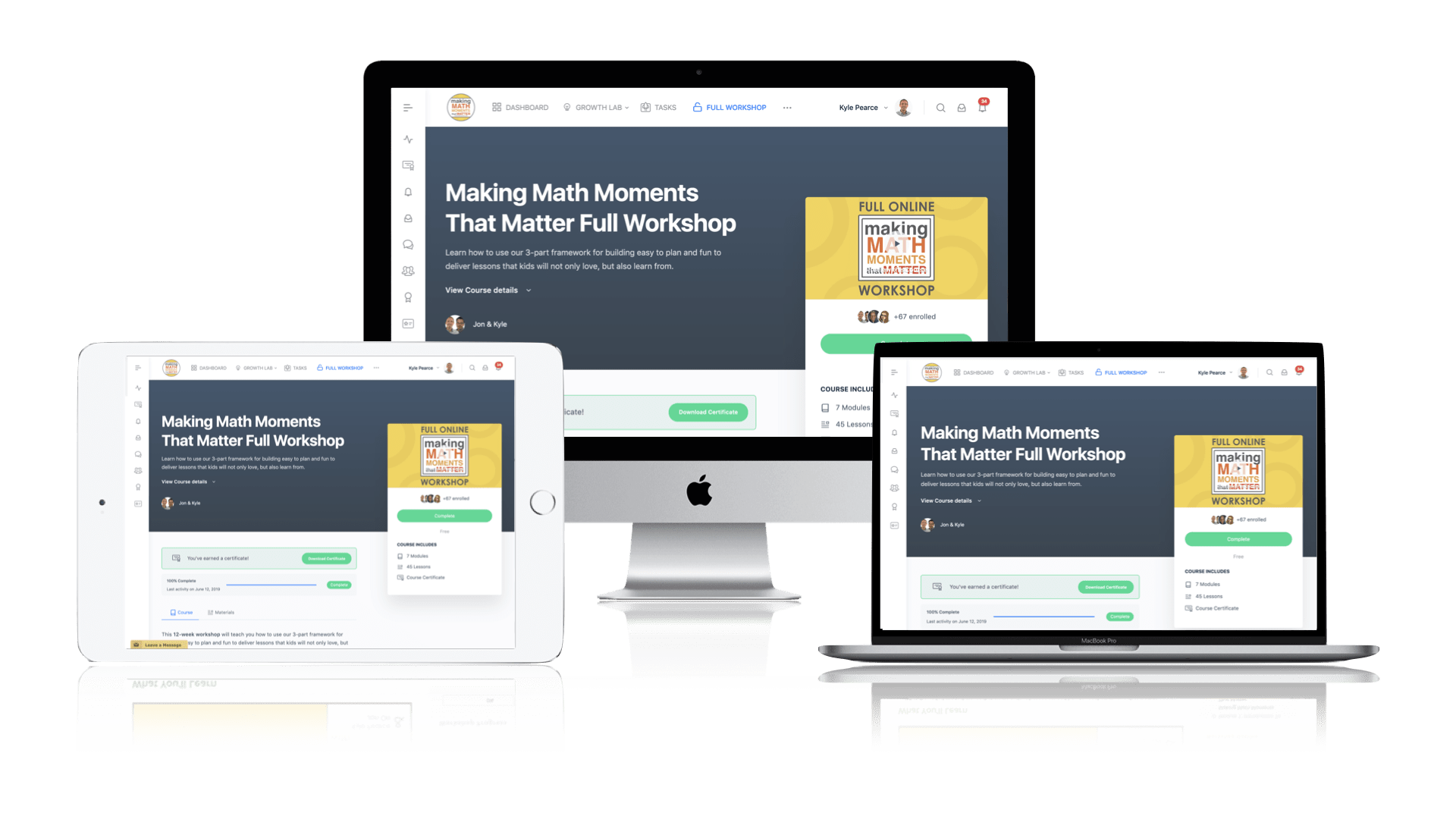
Pedagogically aligned for teachers of K through Grade 12 with content specific examples from Grades 3 through Grade 10.
In our self-paced, 12-week Online Workshop, you'll learn how to craft new and transform your current lessons to Spark Curiosity, Fuel Sense Making, and Ignite Your Teacher Moves to promote resilient problem solvers.
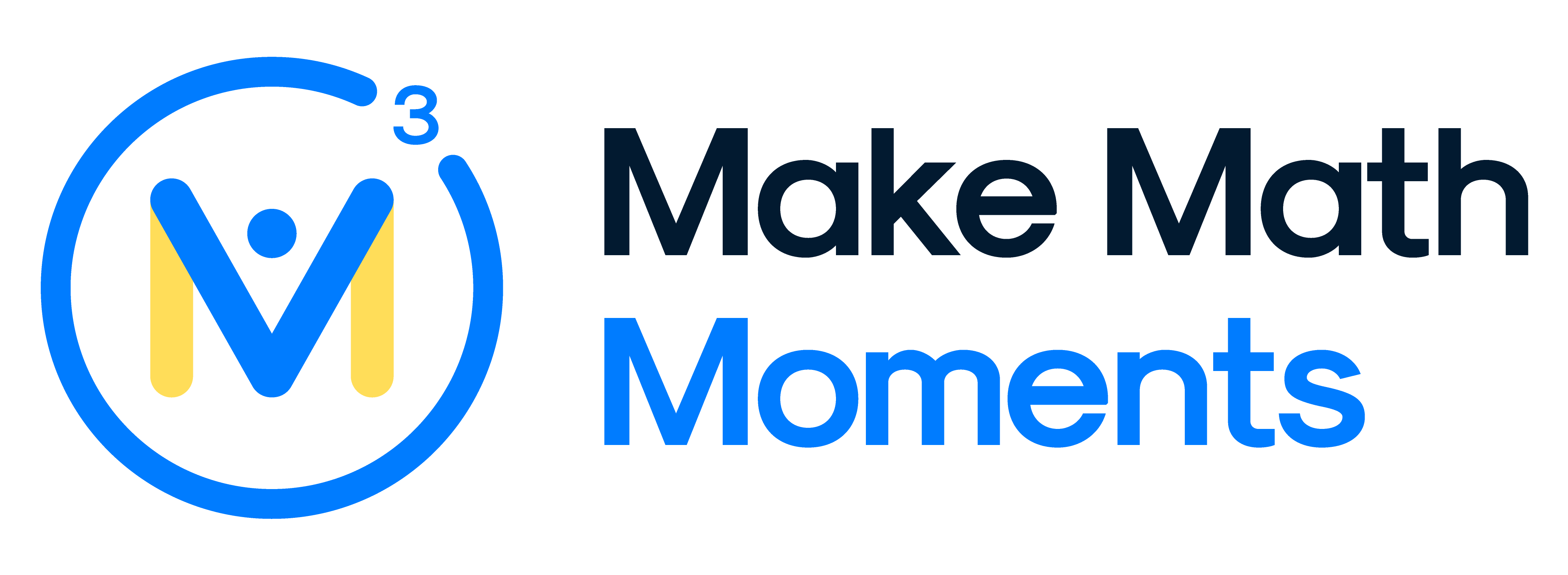



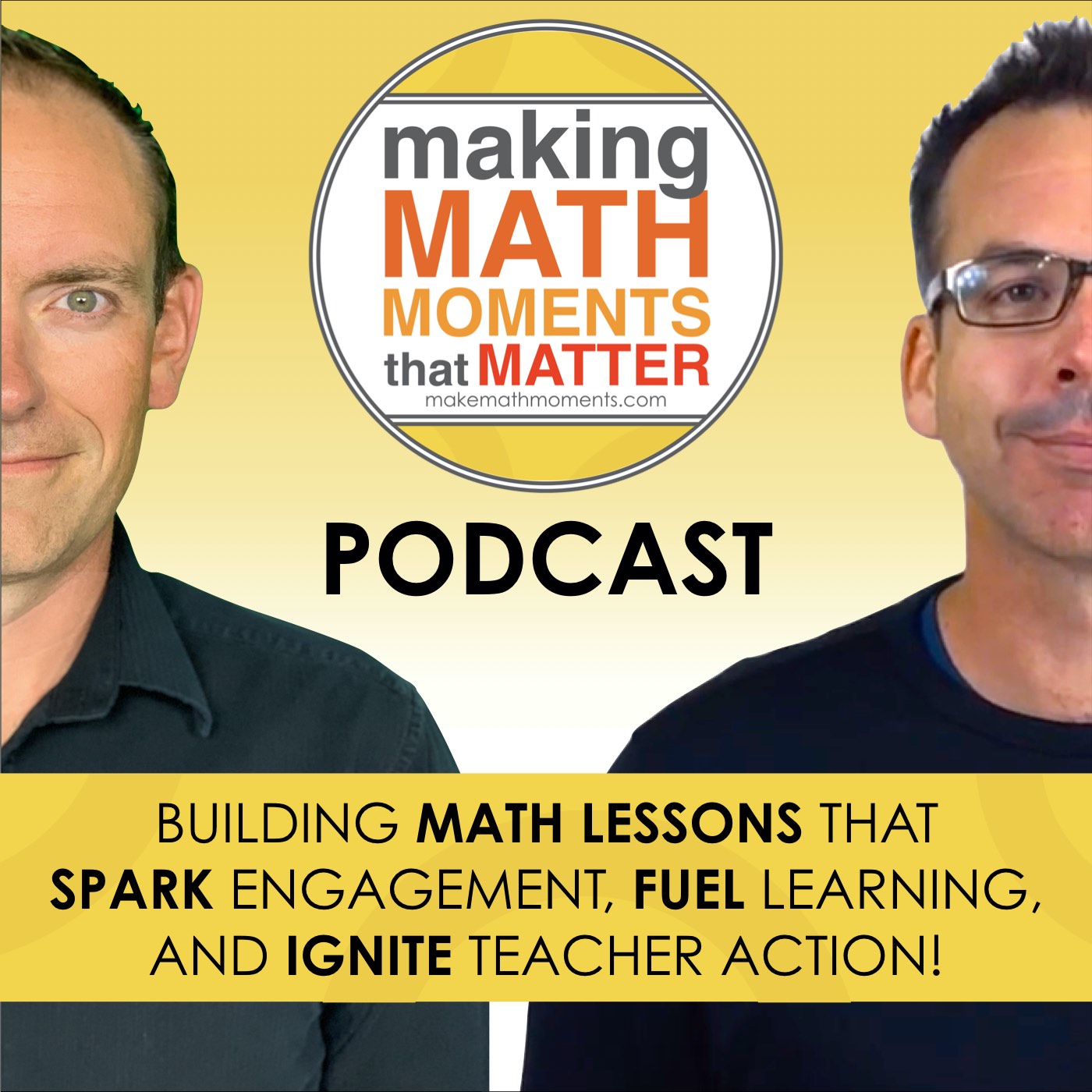
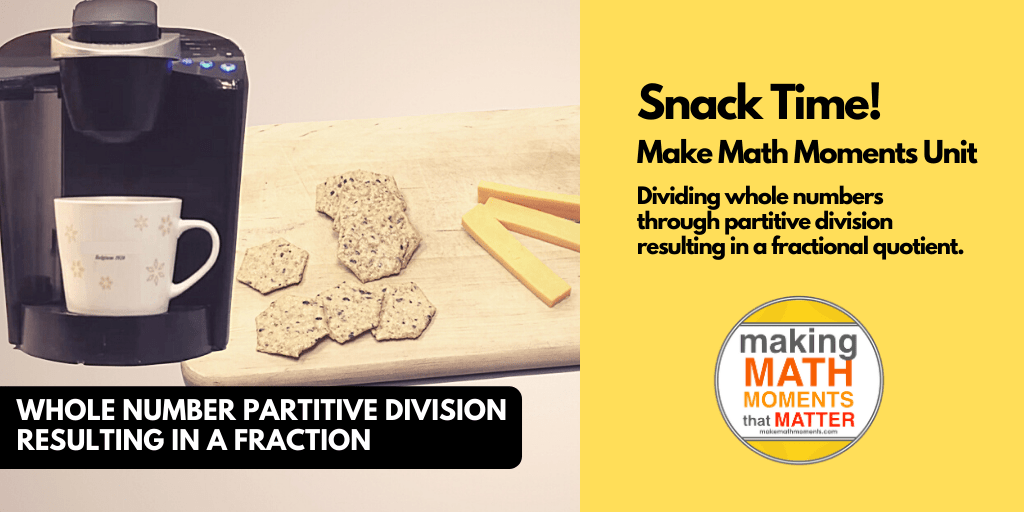

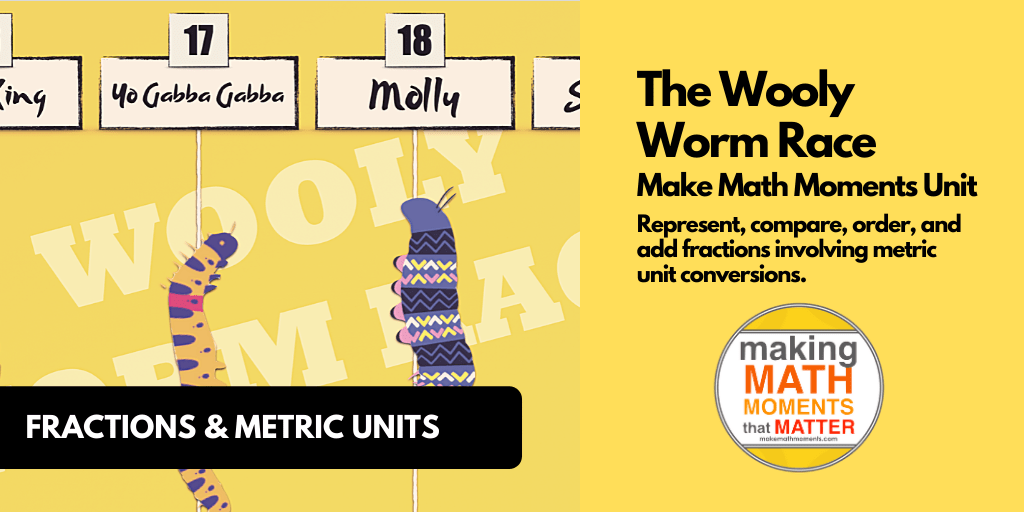
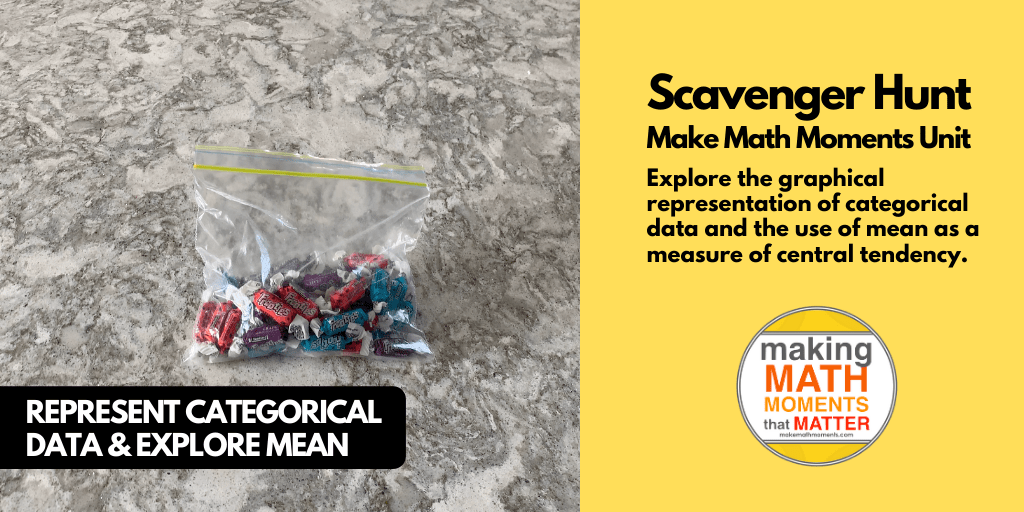
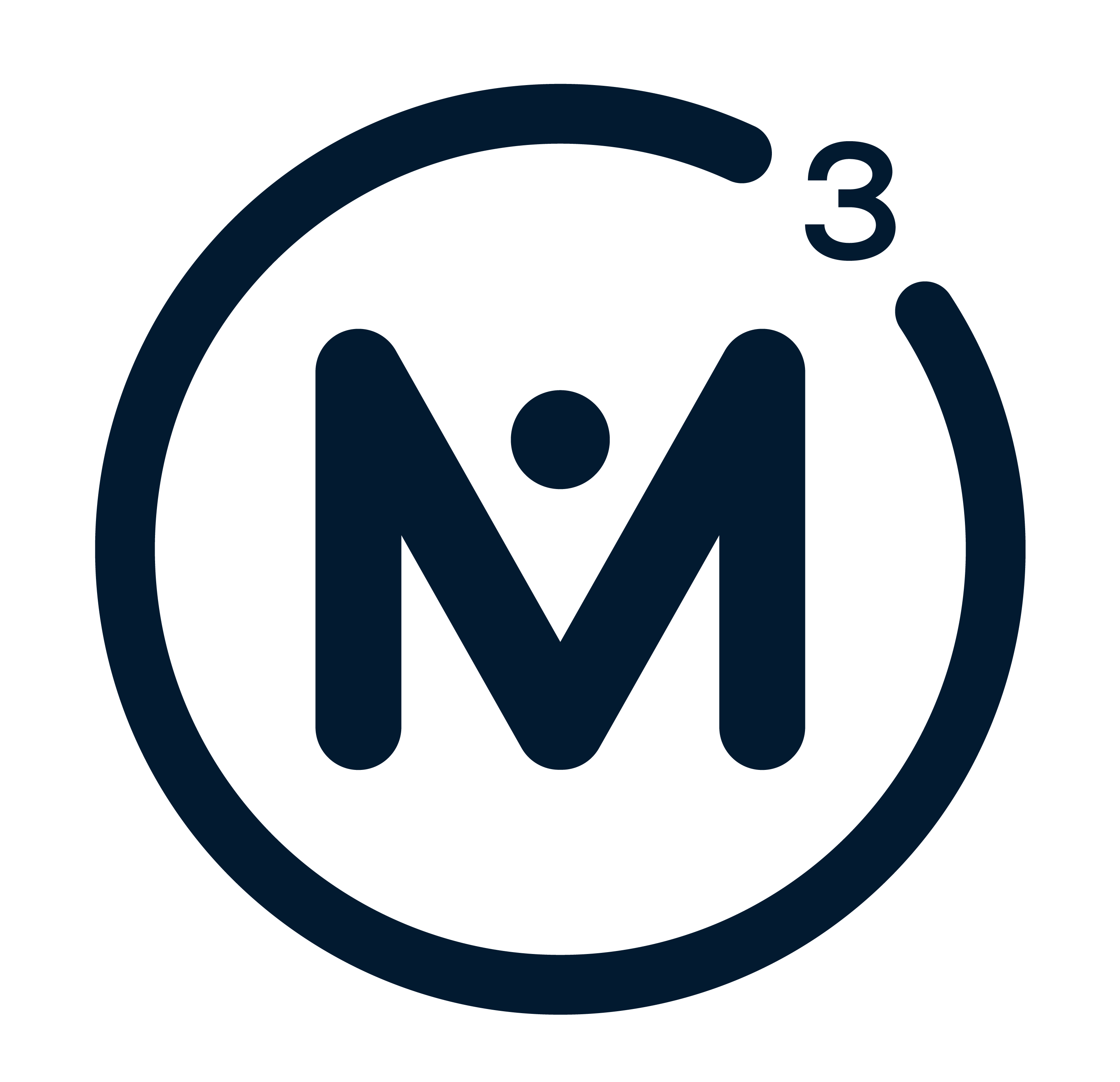
0 Comments